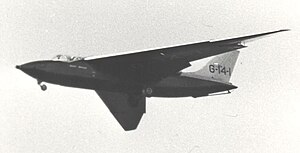Short SB.4 Sherpa
| SB.4 Sherpa | |
|---|---|
 |
|
| Short Sherpa demonstrating at the Farnborough SBAC Show in September 1954 | |
| Role | Experimental aircraft |
| Manufacturer | Short Brothers |
| Designer | David Keith-Lucas |
| First flight | 4 October 1953 |
| Primary users |
Short Brothers company experimental project College of Aeronautics (Cranfield) |
| Number built | 1 |
| Developed from | Short SB.1 |
The Short SB.4 Sherpa was a British experimental aircraft designed and built during the 1950s to test the flight characteristics of the aero-isoclinic wing. It was based upon (and used some components of) the Short SB.1, an earlier glider design.
The Short SB.4 Sherpa was designed by David Keith-Lucas as a research aircraft aimed primarily at assisting in the development of wings for faster, very high-altitude aircraft in general and the company's Preliminary Design (Short PD.1) in response to the U.K. V-Bomber requirement B35/46 in particular. It was the first powered aircraft to employ the "aero-isoclinic" wing first proposed in 1951 by Professor Geoffrey T.R. Hill, who had been instrumental in the design of the Westland-Hill Pterodactyl tail-less experimental aircraft in the mid-1920s.
This radical wing configuration was designed to maintain a constant angle of incidence regardless of flexing, by placing the torsion box well back in the wing so that the air loads, acting in the region of the quarter-chord line, have a considerable moment arm about it. The torsional instability and tip stalling characteristics of conventional swept wings were recognised at the time, together with their tendency to aileron-reversal and flutter at high speed. It was to prevent these effects that the aero-isoclinic wing was designed.
In the Sherpa, the wing, which was used without a tailplane, was fitted with rotating tips comprising approximately one-fifth of the total wing area. These were rotated together (to act as elevators) or in opposition (when they acted as ailerons). They were hinged at about 30% chord and each carried, on the trailing edge, a small anti-balance tab, the fulcrum of which could be moved by means of an electric actuator. It was expected that the rotary wing tip controls would prove greatly superior to the flap type at transonic speeds and provide greater manœuvrability at high altitudes.
...
Wikipedia
